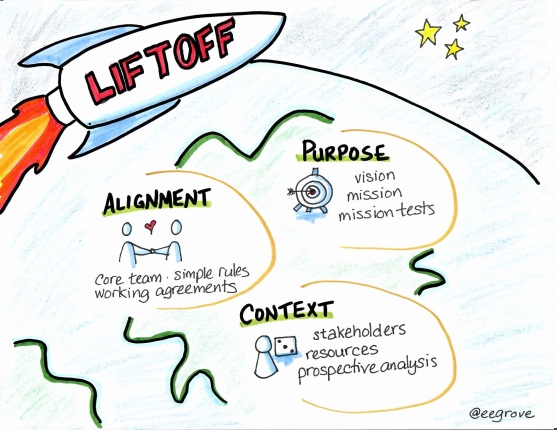The Deceptively Simple Liftoff Checklist
Posted: January 11, 2018 Filed under: Uncategorized Leave a commentAs a coach and facilitator I spend a lot of time helping my clients establish new teams, and sometimes helping existing teams that are in need of a reboot revitalize themselves. I find that it’s critical to invest a little time at the outset to help everyone get on the same page about the problems to be solved and how this particular group of people will work together in this specific environment. This sets up the team so that everyone can work with purpose, make better decisions about the work, and work more effectively with each other and with the team’s partners. This doesn’t have to take a long time – getting everyone together for a day or two of structured conversation can create enough shared understanding that the team can get to work – and my experience has repeatedly demonstrated that a relatively small investment in talking (spoiler: it’s not all talking, actually) together at the outset repays itself many times over in increasing team effectiveness.

Because I can’t make everyone read Diana Larsen and Ainsley Nies’ excellent book Liftoff: Launching Agile Teams and Projects, I’ve created the following 15 item cheat sheet describing the objectives of a liftoff to help explain what a new team might want to sort out at the outset to get themselves off to a more solid start. Each of these items seems straightforward, but it never ceases to amaze me how many different understandings emerge when you sit down with the team and start to dig into these seemingly obvious questions.
The Deceptively Simple Liftoff Checklist
(Important caveat: the team doesn’t need to have a full and complete understanding of every aspect of each of these items to check it off the list – the heuristic here is Good Enough For Now)
Purpose – “Why are we here?”:
- The team has a shared understanding of its vision.
- All team members understand the key business outcomes desired to realize the team’s vision, and the indicators they will look to in order to determine whether they are succeeding at realizing those outcomes.
- Team members know who their customers and partners/stakeholders are
- The team has an initial backlog of valuable work items that will help the team realize the business outcomes
- Team members have a sense of how the business value of work items is defined and where tradeoffs might be considered in meeting customer expectations.
Alignment – “Who are we and how will we work together?”:
- Team members know who is a core member of the team, and who are external contributors who they need to work with to help them deliver.
- The team has articulated its shared values
- Team members have identified simple guiding principles to help them be successful together
- The team has a working agreement outlining specific behaviours they want to support each other in so that they can work effectively together.
- The team has identified the capabilities it possesses and the capabilities it needs to develop in order to deliver reliably and with quality, and to minimize bottlenecks/single-points-of-failure.
Context – “What’s the bigger picture? How do we understand the system and its influences?”:
- The team knows who its stakeholders/partners are, and what information/decisions/resources they need from each other.
- The team understands what decisions about the work have already been made and other constraints that will determine what/how they deliver
- The team has considered the risks and opportunities inherent in their upcoming work, and is actively considering how to mitigate risks and take advantage of opportunities for greater benefit.
- The team knows what resources are needed to deliver, and is working to get the resources it doesn’t currently have in a timely fashion.
- The team has established the initial practices it will use for coordinating, collaborating and communicating its progress.
I’m hoping to unpack each of these objectives in a subsequent post (it’s the new year and I’m optimistic about posting more than once every 18 months), and share some ideas about how you might help the team to check each of these items off and have some fun along the way.


